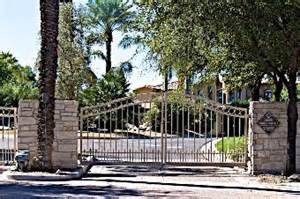
20 May Living in a Gated or Non-gated Community: The Gate Debate
 Living in a gated or non-gated community can be a tough decision for some people in the market for a new home. Sure, there are polarized opinions on both ends of the debate which are completely pro or against one or the other, but what are the real advantages and disadvantages to a a gated community?
Living in a gated or non-gated community can be a tough decision for some people in the market for a new home. Sure, there are polarized opinions on both ends of the debate which are completely pro or against one or the other, but what are the real advantages and disadvantages to a a gated community?
Many people think that there are strong benefits to raising a family inside a gated community. Some who live in gated areas say they feel more secure or are not afraid to be home alone or leave their kids alone in the communities. Often, people who live in the gated neighborhoods feel a sense of safety that they don’t think they would feel in a non-gated community.
An additional benefit advocates for gated communities boast is the lower amount of pass-through traffic in the neighborhood and thus a safer feeling about kids playing in the streets and lower traffic noise.
Another reason some homeowners prefer a gated community is the perceived added prestige to living in such a neighborhood.
In some states, real estate experts say property values of gated communities can be higher than those outside the walls.
No matter the reason for choosing to live in a gated community, the biggest question surrounding gated vs non-gated is safety.
The major question that is asked of gated communities is “Do they really keep crime rates down?” The short answer is, not really. In most cities, some forms of crime such as car theft is reduced initially but the long term crime rates are only marginally better at best. The trend is that crimes against people tend to go down because “outsider” perpetrators initially prefer not to go into areas with which they are unfamiliar and it may be more difficult to escape. Typically, crimes such as burglary drop within the first year of a new gated community but then rise back to the same levels as non-gated communities.
Does living in a gated community give a false sense of security? This is what many people believe; gated communities are more of a marketing tool and fad than serving any true benefit or purpose. For example, in communities with unmanned gates, codes to get into the gates are given to many people who don’t live within the community but visit frequently. Often, friends who don’t live inside the gated community can become irritated with having to remember the code or contacting you for the digits each time they visit. “Outsiders” who get the code not only include friends but also food delivery persons or other individuals providing services to people living inside the gates. Think about all the contractors, landscapers, house cleaners, dog walkers, pest control providers, etc. who enter on a normal basis and consider the level of security coded gates truly provide.
In communities with a guarded gate, the concerns are how good the actual security is. This is solely based upon the person at the gate who is likely being paid a fairly low wage. So, the argument becomes whether that individual would really be willing to go to great lengths to enforce the internal rules of the community. In some cases, where communities have several gate entrances, only the main gate is manned by a person while the others rely on code entry.
No matter the type of gate security, there are ways for perpetrators to get into gated communities and, typically, gates are not enough of a deterrent for the burglars from the affluent homes that often sit inside. Another concern of living within a gated neighborhood is emergency vehicle access to the communities. With more communities being built, and more security codes being used, it can become more difficult for emergency personnel to access the gates. In some areas, rescue workers must rummage through pages of codes for unmanned gates. Another complaint by some rescue workers is maneuvering large emergency vehicles into narrow gates and the response time lost for such instances.
Despite the statistics showing no significant decrease in crime in gated communities over time, the number of these communities continues to grow. While research shows that the “old school” neighborhood watch programs prove to reduce crime if properly run by the community, often these are forgone in a gated community due to the sense of security from the gates and walls alone.
Whether living in a gated or non-gated community, homeowners should always rely on providing their own safety and security first. Locking doors and windows and keeping the garage shut are the most basic forms of safety and other home safety devices or home security alarm systems can always be installed for added measures.
At the end of the day, living in a gated or non-gated community really just comes down to personal preference. There are pros and cons to living in a gated community. The added security is debatable, but that hasn’t stopped them from being a popular choice for families across the country.
For additional information on gated and non-gated communities in The Valley, contact Elise Fay & Associates.


